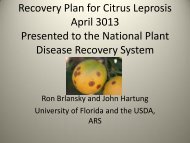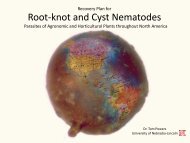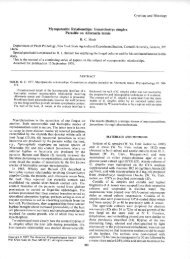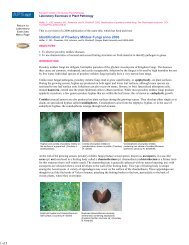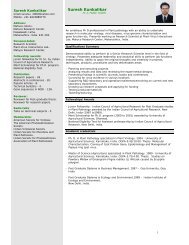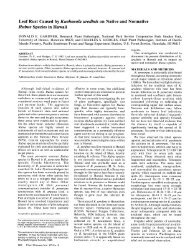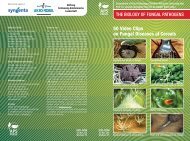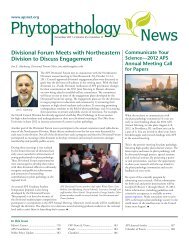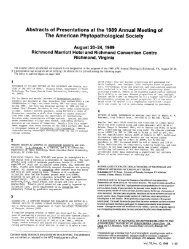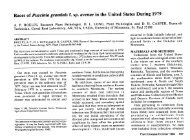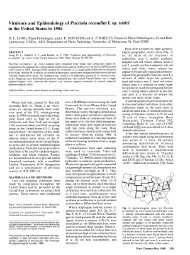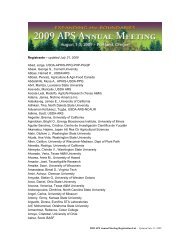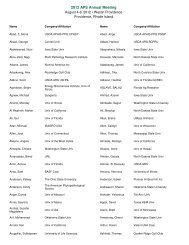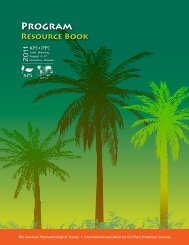Annual Meeting Program Book - American Phytopathological Society
Annual Meeting Program Book - American Phytopathological Society
Annual Meeting Program Book - American Phytopathological Society
Create successful ePaper yourself
Turn your PDF publications into a flip-book with our unique Google optimized e-Paper software.
TuesdaY<br />
Cucurbit Downy Mildew: Re-emergence of a Historical<br />
Disease<br />
1:00 – 3:30 p.m.; C120-122<br />
Section: Plant Disease Management<br />
Organizers: Gerald Holmes, Valent U.S.A. Corporation, Cary,<br />
NC, U.S.A.; David Gent, USDA ARS, Corvallis, OR, U.S.A.<br />
Sponsoring Committees: Epidemiology; Crop Loss Assessment<br />
and Risk Evaluation<br />
Financial Sponsors: Syngenta Crop Protection, Inc., Valent<br />
U.S.A. Corporation<br />
After more than four decades of successful control using<br />
resistant cultivars, downy mildew (caused by Pseudoperonospora<br />
cubensis) reemerged as the single most important problem<br />
facing cucumber production in the eastern United States.<br />
The problem was first detected in North Carolina in 2004<br />
and has since expanded its geographic range to include the<br />
Upper Midwest, parts of Canada, west Texas, and most states<br />
in between. Yield losses have been catastrophic, in some cases<br />
forcing growers to abandon fields within one to two weeks after<br />
disease detection. How did this happen and what has been<br />
the response from producers, extension, industry, and research?<br />
Answers to these questions and the lessons learned along the<br />
way are germane to many pathosystems and to phytopathology<br />
in the broadest sense. This session will feature the programs<br />
that have been on the front lines and will highlight the latest<br />
research and extension efforts on this important pathosystem.<br />
1:00 p.m. S-135. The history and reemergence of cucurbit<br />
downy mildew. G. HOLMES (1), C. Thomas<br />
(2). (1) Valent U.S.A. Corporation, Cary, NC,<br />
U.S.A.; (2) USDA ARS (retired), Charleston, SC,<br />
U.S.A.<br />
1:30 p.m. S-136. Chemical control of cucurbit downy<br />
mildew: A summary of field experiments in the<br />
U.S. G. HOLMES (1), P. Ojiambo (2). (1) Valent<br />
U.S.A. Corporation, Cary, NC, U.S.A.; (2) North<br />
Carolina State University, Raleigh, NC, U.S.A.<br />
1:45 p.m. S-137. Fungicide resistance and management of<br />
cucurbit downy mildew. G. OLAYA (1), P. Kuhn<br />
(1), A. Hert (1), G. Holmes (2), S. Colucci (3).<br />
(1) Syngenta Crop Protection, Vero Beach, FL,<br />
U.S.A.; (2) Valent U.S.A. Corporation, Cary,<br />
NC, U.S.A.; (3) North Carolina State University,<br />
Hendersonville, NC, U.S.A.<br />
2:00 p.m. S-138. Forecasting long distance movement<br />
of Pseudoperonospora cubensis and the cucurbit<br />
ipmPIPE. P. OJIAMBO (1), L. Kanetis (1), G.<br />
Holmes (2). (1) North Carolina State University,<br />
Raleigh, NC, U.S.A.; (2) Valent U.S.A. Corporation,<br />
Cary, NC, U.S.A.<br />
2:30 p.m. S-139. Genetic and pathogenic relatedness of<br />
Pseudoperonospora cubensis and P. humuli. D.<br />
GENT (1), M. N. Mitchell (2), G. Holmes (3).<br />
(1) USDA ARS, Corvallis, OR, U.S.A.; (2) Oregon<br />
State University, Corvallis, OR, U.S.A.; (3)<br />
Valent U.S.A. Corporation, Cary, NC, U.S.A.<br />
3:00 p.m. S-140. Epidemiology of downy mildew: A regional<br />
and molecular approach. B. DAY (1), M.<br />
Hausbeck (1). (1) Michigan State University, East<br />
Lansing, MI, U.S.A.<br />
48<br />
Globetrotting Plant Pathogens and Factors Making a<br />
Difference in Management Outcomes<br />
1:00 – 4:00 p.m.; B113-114<br />
Section: Epidemiology/Ecology/Environmental Biology<br />
Organizers: Jenifer Huang McBeath, University of Alaska,<br />
Fairbanks, AK, U.S.A.; Judith K. Brown, University of<br />
Arizona, Tucson, AZ, U.S.A.; Karen A. Garrett, Kansas State<br />
University, Manhattan, KS, U.S.A.; Richard Lee, USDA ARS<br />
National Clonal Germplasm Repository for Citrus & Dates,<br />
Riverside, CA, U.S.A.<br />
Moderators: Jenifer Huang McBeath, University of Alaska,<br />
Fairbanks, AK, U.S.A.; Karen A. Garrett, Kansas State University,<br />
Manhattan, KS, U.S.A.<br />
Sponsoring Committees: OIP; Tropical Plant Pathology;<br />
Epidemiology & Forest Pathology<br />
This session examines plant pathogens whose long distance<br />
introductions to new regions have resulted in endangerment<br />
of local and national agriculture and ecosystems, extraordinary<br />
economic damage or threats to trade. We also present synthesis<br />
of key factors and strategies attributable to their successful<br />
management.<br />
1:00 p.m. S-141. Globalization and new waves of immigration<br />
of plant pathogens. J. H. MCBEATH (1).<br />
(1) University of Alaska, Fairbanks, AK, U.S.A.<br />
1:30 p.m. S-142. Invasive bacterial pathogens with vectors:<br />
Management success and failure. S. MILLER (1),<br />
R. Lee (2). (1) Ohio State University, Columbus,<br />
OH, U.S.A.; (2) USDA ARS National Clonal<br />
Germplasm Repository for Citrus & Dates, Riverside,<br />
CA, U.S.A.<br />
2:00 p.m. S-143. Advance of the fungi in a world without<br />
borders. D. HUBER (1). (1) Purdue University,<br />
Lafayette, IN, U.S.A.<br />
2:30 p.m. S-144. Capsids with wings. J. BROWN (1), C.<br />
Herron (2). (1) University of Arizona, Tucson,<br />
AZ, U.S.A.; (2) IITA-Tanzania, Dar es Salaam,<br />
Tanzania<br />
3:00 p.m. S-145. Stealth invaders: Lessons on nematode dissemination.<br />
J. OLE BECKER (1). (1) University<br />
of California, Riverside, CA, U.S.A.<br />
3:30 p.m. S-146. Lessons learned for successful management<br />
of invasive pathogens. K. A. GARRETT<br />
(1), M. M. Roca (2). (1) Kansas State University,<br />
Manhattan, KS, U.S.A.; (2) KS & Zamorano<br />
University, Tegucigalpa, Honduras<br />
Mechanisms of Post-Transcriptional Control of Gene<br />
Functions in Plant-Microbe Interactions (AS, PTGS,<br />
Sumoylation and More…)<br />
1:00 – 3:00 p.m.; B117-119<br />
Section: Molecular/Cellular/Plant-Microbe Interactions<br />
Organizers: Paola Veronese, North Carolina State University,<br />
Raleigh, NC, U.S.A.; Steffen Heber, North Carolina State<br />
University, Raleigh, NC, U.S.A.<br />
Sponsoring Committee: Genetics<br />
Plants acquire resistance to environmental stress by reprogramming<br />
gene expression and metabolism, gaining a new



